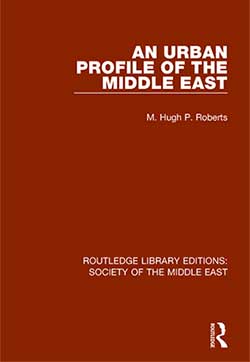An Urban Profile of the Middle East

This book was originally written in 1979 to capture the changes in Middle Eastern societies and economies which were prevalent at the time. It looked at the origins of urban development in the region, which contain some of humanity’s earliest urban settlements, and traces patterns of change through to the modern era. These include the origins of the widespread absence of sustainability that dominated urbanisation through the middle of the 20th century, based on over dependence on the ever expanding hydrocarbons economies at the time. Predictions for urban trends such as migration patterns, economic growth and homelessness made at the time provide a useful backdrop to what has really happened since 1980.
The book also touches on the dislocation between many citizens of the rapidly changing societies and their own fortunes , as well as possible reactions in terms of a return to more fundamental religious values. Given the history of social turmoil from Algeria, Tunisia, Libya, Egypt, Kuwait, Iraq, Syria, Yemen and others in the intervening 4 decades, the book has proved remarkably prescient. It demonstrates that physical environments are one of the strongest factors in determining well being or its opposite across diverse societies. Such measures of social morale seemed to still be in their infancy until the start of the 21st century.
The second section of the book looked at a series of case studies in urban master planning from North Africa to Oman and the very beginnings of awareness of an acute need for more sustainable design and building solutions. Courses of action for the creation of urban ways of life more suited to the physical, social, economic and environmental determinants of Middle Eastern life remain as relevant today as they did at time of writing in 1979. As a result the book was re-published as a Library Edition in 2017.
Chapter headings
1. Urban Development in Society – Why and how societies become urbanised.
2. Traditional Middle Eastern Urbanisation – How urban forms evolved in this region.
3. Economic Motivation for Change – What is happening to change society economically and socially.
4. Urban Revolution in the Middle East – Statistical data about changes in urban population and primacy.
5. The Habitat Conference on Human Settlements, Vancouver June 1976 – Patterns of change in 8 Middle Eastern countries.
6. Case Studies New Towns – Sidi Ammar, Algeria; Umm Said, Qatar; Jebel Ali, UAE.
7. Case Studies Development other than new towns – Kuwait’s Structure Planning; Shahestan Pahlavi, Iran; Economic and Social transitions in Oman; Nador steel town Morocco.
8. Case Study A Research Study into Future Settlement Patterns in the Middle East – Sustainable urban solutions for dry countries.
9. An Urban future for the Middle East – The challenges for future urban society across the region.